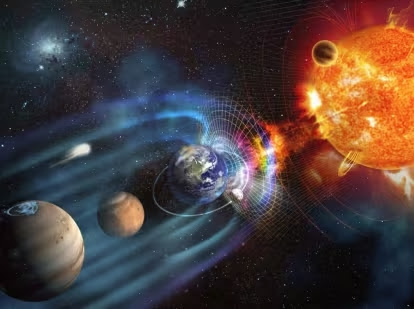GEOPHYSICAL !
For those who have studied the course of Geomagnetism at the University we can remember a topic of study about our star the Sun and how it is that due to its activity greatly influences our planet causing spectacular phenomenon known as the aurora borealis , and not counting on harmful effects on our communication systems and electronic when solar storms going towards our planet occur . So we can say that the sun is a celestial body of great impact on our planet , but the question is really whether we really know our Sun in its entirety.
Do you really know what you do?
We already know much about the Sun and its influence on our planet , but even know such things as what is the area most violent sun or how the material is hundreds of thousands of degrees hot.
The only tool capable of performing these studies is using special satellites whose sole purpose is to study these features , of course , that's what they were built.
For this, NASA is responsible for making these studies to determine in more detail how it moves and our star material is heated .
As I mentioned , NASA , recently, on June 29 , he could launch into space toward the Sun a Satellite IRIS name, whose mission is to study how the solar material moves, stores energy and heat in the process, reaching a region little known to man between the surface and the solar corona.
Recall that the solar corona is the outermost layer of the sun is composed of plasma and extends over a million miles from its origin on the chromosphere . ( 4)
Note that this region to be studied is what drives the solar wind in all directions and is sonde ultraviolet output of the sun is generated and Now you can give an idea of the importance of this study ? For this this satellite high resolution photographs taken every few seconds up to 240 km across the Sun ( 1)
So far this TV has been photographing and sending detailed images of Earth inner solar atmosphere , and to our luck it will continue over the next two years.
Adrian Daw , associate scientist, said : " ... the solar atmosphere IRIS show more detail than has ever been seen before ... " and you are sure to find something that he said did not expect to see .
John Grunsfeld , another scientist on the mission said : " ... the front door to a new era in solar physics ... " ( 2)
Now! These days is being held in San Francisco , USA, the American Geophysical Union , where it has been made public that the area between the solar corona and the solar surface is a highly violent region , as expected .
Alan Title, principal investigator stated : " ... the quality of the images and spectra we are receiving from IRIS is amazing ... "
For the first time , IRIS is making possible the study of explosive phenomena in the Solar area with sufficient detail to determine their role in the heating of the outer atmosphere of our star. Observations of the mission also open a new window into the dynamics of the lower solar atmosphere , which play a key role in accelerating the solar wind leading to eruptive events . ( 3)
The researchers explained that this region always was dynamic and have now realized that it is very violent and turbulent .
Bart De Pontieu , another scientist explained, " ... we are seeing unprecedented rich images of violent events in which the gases are accelerated to very high speeds while rapidly heated to hundreds of degrees ... This type of observations present significant challenges for current theoretical models ... "
Two events on the Sun that are taken into account in studies are prominences or cold spots within the intermediate region that appear as giant loops of solar material that rise above the surface. And the other are the spicules , giant gas sources as long as our planet that may play a role in the distribution of heat and energy in the corona.
Who wants those pictures ?
Do not forget to leave your comments on our blog or email us at marvar26@gmail.com
references
( 1) http://www.abc.es/ciencia/20130629/abci-nasa-lanza-nuevo-espia-201306281617.html
( 2) http://www.abc.es/ciencia/20130726/abci-nasa-iris-201307261546.html
( 3) http://www.abc.es/ciencia/20131210/abci-telescopio-nasa-obtiene-imagenes-201312091820.html
( 4) http://es.wikipedia.org/wiki/Corona_solar
For those who have studied the course of Geomagnetism at the University we can remember a topic of study about our star the Sun and how it is that due to its activity greatly influences our planet causing spectacular phenomenon known as the aurora borealis , and not counting on harmful effects on our communication systems and electronic when solar storms going towards our planet occur . So we can say that the sun is a celestial body of great impact on our planet , but the question is really whether we really know our Sun in its entirety.
Do you really know what you do?
 |
| Satellite IRIS |
We already know much about the Sun and its influence on our planet , but even know such things as what is the area most violent sun or how the material is hundreds of thousands of degrees hot.
The only tool capable of performing these studies is using special satellites whose sole purpose is to study these features , of course , that's what they were built.
For this, NASA is responsible for making these studies to determine in more detail how it moves and our star material is heated .
As I mentioned , NASA , recently, on June 29 , he could launch into space toward the Sun a Satellite IRIS name, whose mission is to study how the solar material moves, stores energy and heat in the process, reaching a region little known to man between the surface and the solar corona.
 |
| Sun |
Note that this region to be studied is what drives the solar wind in all directions and is sonde ultraviolet output of the sun is generated and Now you can give an idea of the importance of this study ? For this this satellite high resolution photographs taken every few seconds up to 240 km across the Sun ( 1)
So far this TV has been photographing and sending detailed images of Earth inner solar atmosphere , and to our luck it will continue over the next two years.
Adrian Daw , associate scientist, said : " ... the solar atmosphere IRIS show more detail than has ever been seen before ... " and you are sure to find something that he said did not expect to see .
John Grunsfeld , another scientist on the mission said : " ... the front door to a new era in solar physics ... " ( 2)
Now! These days is being held in San Francisco , USA, the American Geophysical Union , where it has been made public that the area between the solar corona and the solar surface is a highly violent region , as expected .
Alan Title, principal investigator stated : " ... the quality of the images and spectra we are receiving from IRIS is amazing ... "
For the first time , IRIS is making possible the study of explosive phenomena in the Solar area with sufficient detail to determine their role in the heating of the outer atmosphere of our star. Observations of the mission also open a new window into the dynamics of the lower solar atmosphere , which play a key role in accelerating the solar wind leading to eruptive events . ( 3)
 |
| American Geophysical Union |
Bart De Pontieu , another scientist explained, " ... we are seeing unprecedented rich images of violent events in which the gases are accelerated to very high speeds while rapidly heated to hundreds of degrees ... This type of observations present significant challenges for current theoretical models ... "
Two events on the Sun that are taken into account in studies are prominences or cold spots within the intermediate region that appear as giant loops of solar material that rise above the surface. And the other are the spicules , giant gas sources as long as our planet that may play a role in the distribution of heat and energy in the corona.
Who wants those pictures ?
Do not forget to leave your comments on our blog or email us at marvar26@gmail.com
references
( 1) http://www.abc.es/ciencia/20130629/abci-nasa-lanza-nuevo-espia-201306281617.html
( 2) http://www.abc.es/ciencia/20130726/abci-nasa-iris-201307261546.html
( 3) http://www.abc.es/ciencia/20131210/abci-telescopio-nasa-obtiene-imagenes-201312091820.html
( 4) http://es.wikipedia.org/wiki/Corona_solar































Our Star the Sun will always be from every point of view a very dynamic, violent celestial body. When we heard that the sun is quiet? So the response from scientists was more than obvious. Better we should think about how to harness that energy when our synthetic energy resources are exhausted, out of the applications of solar energy with solar panels or photovoltaic cells.
ResponderEliminarAnd how the material is heated to the Sun thousands of degrees Celsius?
ResponderEliminar